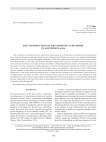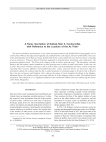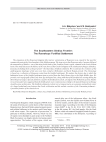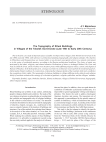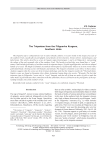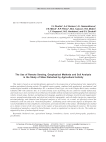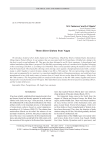The metal ages and medieval period. Рубрика в журнале - Archaeology, Ethnology & Anthropology of Eurasia
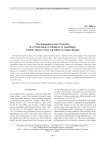
Статья научная
The objective of this article is to clarify certain important issues relating to early urban culture. The complexity of the task stems from the absence of early written sources. This is why the study draws on archaeological materials. It especially focuses on the incipient proto-urban sites—the sources of the proto-urban culture. Certain Bronze Age settlements in Azerbaijan meet the criteria of the early urban civilization. On the basis of the facts cited here, hypotheses about the factors underlying the emergence of proto-urban centers (the harbingers of the first class societies) are put forward. The main features of proto-urban settlements are surface area, structure, fortifications, population size, and population density. The evolution of crafts in such centers is reconstructed along with other aspects. It is argued for the first time that nearly all cultural values typical of the advanced ancient Near Eastern centers were borrowed by South Caucasians. Monumental Late Bronze Age burial mounds of Karabakh are viewed in the context of proto-urban evolution. The idea that elite burials were connected with early urban centers is based on the fact that only powerful chiefs of large tribal unions and early class societies could afford monumental burials on such a scale.
Бесплатно
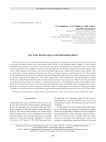
The final Bronze Age in the Minusinsk basin
Статья научная
Based on the most recent excavation fi ndings, this article discusses a disputable group of burials, previously believed to represent the Bainov stage of the Tagar culture (900–700 BC) in the Minusinsk Basin. Analysis of these burials unambiguously supports I.P. Lazaretov’s idea that they fall into two independent and unrelated groups. One of them continues Late Bronze Age traditions, whereas the other demonstrates new features exclusively associated with the Tagar culture. Most complexes of the Bainov type represent the fi nal stage in the evolution of Late Bronze Age traditions. This is evidenced by various categories of grave goods, features of burial structures, and the funerary rite. These burials can be attributed to stage IV of the Late Bronze Age in the Minusinsk Basin. The second, smaller group reveals entirely new features, typical of the Podgornoye stage of the Tagar culture. These include novel structural features in kurgan architecture, different female funerary attire, and the custom of placing weapons in graves. This attests to the arrival of a new population group with its own traditions, resulting in the emergence of a Scythian type culture on the Middle Yenisey. These burials should be attributed to the beginning of the Podgornoye stage of the Tagar culture. Hopefully, future studies will help to separate out a special late group of Bainov burials, contemporaneous with the early Podgornoye kurgans. Currently, it is possible to discern certain features suggesting that this population took part in the origin of the Tagar culture.
Бесплатно
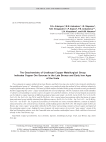
Статья научная
Trace elements in copper artifacts from Late Bronze and Early Iron Age sites in the Urals, formerly attributed to the metallurgical group of “chemically pure” copper, were analyzed using the method of laser ablation inductively coupled plasma mass spectrometry. The metal of which artifacts included in this group are made reveals geochemical markers suggesting that “pure” copper actually falls into several subgroups. The PCA analysis of the results identifies 11 clusters corresponding to various sources of copper ores and their mixtures. At least seven principal associations can be linked to copper deposits of different geological types and origin: Au-Te-Bi, Au-Se-Te-Sb, Fe-Co-Ni-As-Sb, Fe-Co-Ni -Zn, Se-Co-Fe, Ag-Pb-Ni, and Sb-Pb-Zn-As. Also, several mixed associations reflect the fusion of copper items and metal scrap initially obtained from different sources: Sn-Pb, Fe-Co-Ni-Zn + Sn, Fe-Co-Ni + Au-Te-Bi-Ag, Fe-Co-Ni + Au-Te-Bi + Sn. A separate association, for which the ore source remains unknown, consists of artifacts characterized by a low content of trace elements, jointly making up less than 0.01 wt%. The largest sample in the Late Bronze Age “pure copper” group falls within the Sn-Pb cluster representing a mixture of local copper and imported Sn-containing copper scrap. Judging by trace elements, the main sources of ore in the “pure copper” group of the Itkul and Sarmatian cultures were the Gumeshki mine and another unidentified source. Both could have been used already in the Final Bronze Age.
Бесплатно
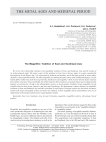
The megalithic tradition of East and Southeast Asia
Статья научная
We review the scholarship relating to the megalithic tradition of East and Southeast Asia and the results of its archaeological study. The major center of this tradition in East Asia is Korea, where it reveals considerable heterogeneity. In the Bronze Age, it is represented by dolmens and menhirs, and in the later periods by stone tombs, chambers, and pyramidal mounds. The latest megaliths are anthropomorphic statues of the Dolhareubang type, on Jeju Island off the southern tip of the Korean peninsula. Southeast Asian megaliths, which are described in detail, originate from similar structures in East and South Asia while being less known and less accurately dated, and revealing specific features of construction. Owing to the ethnographic sources on local peoples, Southeast Asian megaliths provide valuable data on their layout, function, and associated mythology. We demonstrate common features in megalithic traditions of East and Southeast Asia and their specificity in each region. Principal sources are described, and major trends in the study of megaliths in those territories are outlined. In sum, megaliths of East and Southeast Asia are an independent archaeological phenomenon requiring future studies.
Бесплатно
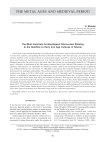
Статья научная
On the basis of the current knowledge, key archaeological discoveries made in Siberia and the Russian Far East over the three centuries, and spanning the interval from the Neolithic to the Early Iron Age, are assessed. Principal scholars and their works are listed. Rescue excavations have made it possible to construct archaeological typologies and to model historical and cultural processes. D.G. Messerschmidt’s role as the discoverer of the Early Iron Age of Khakassia and of the Tom rock art site is described. Later, this rock art site was thoroughly studied by A.P. Okladnikov and A.I. Martynov. Achievements of the 20th century continued those of the 18th and 19th centuries. On the basis of typologies elaborated by S.A. Teploukhov for Khakassia, similar cultural and chronological models for neighboring areas of Western Siberia were constructed. A.P. Okladnikov’s typology for the Cis-Baikal Neolithic and Bronze Age were elaborated by his colleagues and students. The earliest stages of the Amur Neolithic with the most ancient ceramics in Northern Asia, dating to 16,780–14,200 cal BC, were described. E.N. Chernykh’s and S.V. Kuzminykh’s theory of SeimaTurbino—a transcultural phenomenon of key importance for the Eurasian Bronze Age—is outlined. While its basic features are better known today, their theory has retained its relevance. With regard to the Early Iron Age, the major excavations concerned mounds such as Arzhan-1, Arzhan-2, and Chinge-Teya-1 in Tuva. In the Altai Mountains, likewise outstanding Pazyryk kurgans (600–200 BC) were excavated. An entirely new stage in Scythian age archaeology was marked by N.V. Polosmak’s excavations of “frozen”, undisturbed burials of middle-ranking and low-ranking Pazyryk people on the Ukok Plateau. Similar burials were excavated by Z. Samashev and H.P. Francfort on the western slopes of the Altai. Pazyryk chronology was elaborated owing to the use of the tree-ring analysis.
Бесплатно
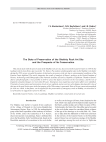
The state of preservation of the Shakhty rock art site and the prospects of its conservation
Статья научная
This article deals with the preservation of the Shakhty rock art site, discovered in the Eastern Pamirs in 1958 by the leading Central Asian Stone Age researcher V.A. Ranov. The analysis of photographs taken in the Shakhty rock shelter during the 2019 survey revealed the nature of destructive processes at the site due to environmental conditions of the Eastern Pamir highland. The article integrates the results of analysis of Ranov's archives at the Donish Institute of History, Archaeology and Ethnography of the National Academy of Sciences, Republic of Tajikistan. Thanks to Ranov's diaries and photographs, it was possible in 2019 to assess the degree of erosion on the rock surface, and the loss of fragments of painted images over more than 60 years. Emergency areas requiring conservation efforts were identified. Principles of conservation and restoration of rock art are outlined, and an overview of techniques developed for sites of this type in the post-Soviet space in the last quarter of the 20th century is presented. State of the art conservation methods for rock art, which, in the future, can be applied for the preservation of emergency areas at Shakhty, are described. A set of measures is suggested to preserve this site.
Бесплатно
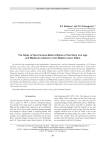
Статья научная
We describe the morphological and quantitative characteristics, and the elemental composition, of 23 bronze artifacts, seven silver ones, and a gold adornment, spanning the period from late 11th century BC to 15th century AD. These items (adornments and tools) belong to the Uril and Talakan cultures of the Early Iron Age, Mikhailovka, Mohe, and Central Asian cultures of the Early Middle Ages, and the Ducher culture of the Late Middle Ages. Elemental analysis of the bronze items at the SB RAS Institute of Nuclear Physics Siberian Center for Synchrotron and Terahertz Radiation Station of Local and Scanning X-Ray Fluorescence Elemental Analysis showed that over about 2.5 thousand years, tin-lead or lead-tin bronze was used for manufacture. Also, the best convergence of concentrations of chemical elements for Talakan and Mikhailovka artifacts testifies to evolutionary continuity between the Talakan and Mikhailovka cultures. Analysis of the elemental composition of Mohe silver and gold items from the Amur basin was carried out for the first time, revealing the high purity of precious metals used for manufacturing early medieval jewelry.
Бесплатно
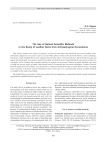
The use of natural scientific methods in the study of leather items from archaeological excavations
Статья
Бесплатно
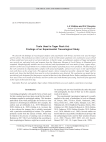
Tools used in Tagar rock art: findings of an experimental traceological study
Статья научная
We describe the findings of traceological analysis and experiments with bronze and iron tools used by Tagar and Tes artists. The pecking traces these tools leave on the red Devonian sandstone were examined to assess which of them could have been used in rock art production. At the first stage, a preliminary analysis of Tagar petroglyphs was carried out, and metal tools and weapons from the Martyanov Museum of Local History in Minusinsk were examined. Morphologically suitable ones were selected, and experimental tools were made of stone, copper alloys, and low-carbon steel. Experiments were conducted and samples of pecking traces were produced. The final stage of the work consisted of comparing these samples with actual petroglyphs, and use-wear traces on the experimental tools with those on the actual tools. This approach made a direct comparison possible. Among the Tagar and Tes metal tools, those that had likely been used in rock art production were detected. The conclusion was made that no specialized tools designated for that purpose existed at that time in the Minusinsk Basin. Rather, multifunctional tools were used. These were made of tin bronze and low-carbon steel with thermal processing. Such tools first appeared in the region in the Early Iron Age.
Бесплатно

Traces of the Dahaean and Sarmatian cultural legacy in Ancient Turan and Old Rus
Статья
This study examines the migrations of the Dahae and Sarmatians—the two related early nomadic peoples of Middle Asia and Eastern Europe—directed to the south and west of their homeland. Archaeological, written, and folkloric sources make it possible to trace the migrations of the Dahae and Sarmatians over several centuries preceding the spread of Islam in Central Asia and of Christianity in Old Rus. The study focuses on mortuary monuments, temples, and sanctuaries, cross-shaped in plan view, of migrants and their descendants. A detailed analysis of the major southward migration of Dahae from the Lower Syr-Darya in the late 3rd to early 2nd BC is presented. This migration had a considerable effect on ethnic and cultural processes in Middle Asia. The migration aimed at conquering the lands of Alexander the Great’s descendants, who were rapidly losing control over them. Features of Dahaean culture are noticed in town planning, architecture, mortuary rites, armor, etc. over the entire territory they had captured. Southward migration of the descendants of the Dahae—people of the Kaunchi and Otrar cultures—from the Syr-Darya, led by the Huns, was part of the Great Migration. The Kaunchi people headed toward the oases of Samarkand and Kesh, the Otrar people toward the oasis of Bukhara, and those associated with the Dzhetyasar culture toward the Qarshi oasis. It is demonstrated that while the cross-shaped plan view of religious structures turned into the eight-petaled rosette, the fu neral rite did not change, remains of burials and charcoal are observed everywhere. Relics of the ScythoSarmatian legacy are seen in the culture of Old Rus. For instance, remains of the sanctuaries of Perun are walls and ditches arranged in a cruciform or eight-petaled fashion, fi lled with charcoal and bones of sacrifi ced animals, with a statue of the supreme Slavic deity, in the center. Early sanctuaries of Perun in Kiev and Khodosovichi were cruciate in plan view, while later ones on the banks of the Zbruch and the Volkhov rivers had octopetalous plans. Apparently they were infl uenced by the architectural traditions of Dahae and Sarmatians, who took part in the ethnogenetic processes in both Old Rus and Turan.
Бесплатно
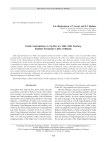
Turkic inscriptions in Cyrillic on 14th-15th century eastern European Lithic artifacts
Статья обзорная
Бесплатно


